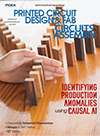News
TORONTO -- EMS provider SMTC Corp. today
reported fiscal 2004 net earnings of $1.3 million on revenue of $245
million. This compares with a net loss of $40 million on revenue of
$306 million last year.
The fourth-quarter net loss narrowed but sales declined sharply. Revenue and earnings were hurt by an unanticipated volume decline from a major customer that operates in a cyclical sector, the company said.
For the year the company generated $5.1 million in cash from operations. down from $5.5 million for 2003.
In a press release, John Caldwell, president and chief executive, said, "We expect to produce sequential revenue growth by the second quarter of 2005 and continue with positive momentum through the back half of the year."
The fourth-quarter net loss narrowed but sales declined sharply. Revenue and earnings were hurt by an unanticipated volume decline from a major customer that operates in a cyclical sector, the company said.
For the year the company generated $5.1 million in cash from operations. down from $5.5 million for 2003.
In a press release, John Caldwell, president and chief executive, said, "We expect to produce sequential revenue growth by the second quarter of 2005 and continue with positive momentum through the back half of the year."
For the fourth quarter the company reported a net loss of
$2.5 million on sales of $48 million. SMTC took $700,000 in restructuring
and other one-time charges. SMTC lost $2.6 million on revenue of $76.9 million a year ago.
PHOENIX -- Suntron Corp.
today reported net sales of
$115.8 million and a net loss of $1.3 million for its fourth quarter
ended Dec. 31.
For the year, the EMS maker posted a net loss of $4.5 million on net sales of $475.4 million.
For the year, the EMS maker posted a net loss of $4.5 million on net sales of $475.4 million.
For the quarter net sales were up 47%
increase from last year on higher demand for semiconductor capital equipment, aerospace and
defense, industrial and medical gear. The net loss was $1.3 million, vs. a net loss of $6.1 million.
For the year, the net loss was $4.5 million, vs. a net loss of $34.3 million in 2003.
The operating loss improved to $400,000 from $5.5 million
a year ago. Sequentially, fourth-quarter net sales decreased 10%, due to lower
demand for semiconductor tools.
FRAMINGHAM, MA -- February brought a slight rebound in projected IT spending after declines over the previous three months, CIO magazine said today.
Chief information officers predict spending growth of 5.9% over the next 12 months, up from 5.4% reported during January, according the magazine's monthly poll.
Telecom equipment and infrastructure software had the largest number of CIOs who predict increases.
"The February results are somewhat reassuring" said Gary Beach, group publisher of CXO Media, the company that publishes CIO. "After three straight monthly declines, it is a good sign we are seeing some leveling off. CIOs are now facing
a more constrained environment and must make hard choices between infrastructure maintenance and system upgrades. I believe in the coming months we will see a slow but steady rate of growth. However, unless the CEO and CFO loosen the
purse strings, we will not see explosive growth."
"Although IT spending projections improved modestly from January levels, CIO spending expectations have declined noticeably from last fall," said Chris Whitmore, director IT hardware research for Deutsche Bank Securities. "The upswing
this month in the telecom and infrastructure software markets is one highlight in the data. However, it remains to be seen if this is the beginning of a trend."
Chief information officers predict spending growth of 5.9% over the next 12 months, up from 5.4% reported during January, according the magazine's monthly poll.
Telecom equipment and infrastructure software had the largest number of CIOs who predict increases.
"The February results are somewhat reassuring" said Gary Beach, group publisher of CXO Media, the company that publishes CIO. "After three straight monthly declines, it is a good sign we are seeing some leveling off. CIOs are now facing
a more constrained environment and must make hard choices between infrastructure maintenance and system upgrades. I believe in the coming months we will see a slow but steady rate of growth. However, unless the CEO and CFO loosen the
purse strings, we will not see explosive growth."
"Although IT spending projections improved modestly from January levels, CIO spending expectations have declined noticeably from last fall," said Chris Whitmore, director IT hardware research for Deutsche Bank Securities. "The upswing
this month in the telecom and infrastructure software markets is one highlight in the data. However, it remains to be seen if this is the beginning of a trend."
Press Releases
- Kitron Strengthens Order Backlog with EUR 11 Million Contract for Defense Communication
- ZTEST Electronics Inc. Announces Transition to the OTCID Market
- SEMI and TechSearch International Release 2025 Edition of Worldwide Semiconductor Assembly & Test Facility Database
- Coherix Unveils Industry-First Service Program for Adhesive Dispensing Systems
POPULAR
- Editorial Contributions
- Smarter SMT Starts at the Reel: How Splicing Kits are Powering Efficiency
- Verifying PCBA Cleanliness with Ion Chromatography
- Factors Contributing to Solder Ball Formation: A Guide
- Systematic Troubleshooting in Electronics Assembly: A Case Study in Solder Balling and Process Optimization


